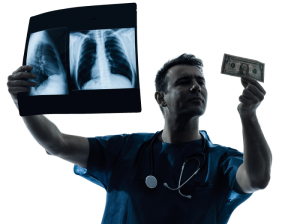Medicare pay cuts to push providers using film and CR toward DR systems
by Gail Kalinoski, Contributing Reporter | May 26, 2016
Business Affairs
X-Ray

Providers brace for Consolidated
Appropriations Act of 2016
Appropriations Act of 2016
Hospital outpatient facilities and physicians’ offices still using analog and CR X-ray equipment need to begin thinking about making the switch to DR in order to avoid Medicare reimbursement reductions starting next year.
As part of the $1.1 trillion omnibus spending bill passed by Congress and signed into law by President Barack Obama in mid-December, provisions in the Consolidated Appropriations Act of 2016 contained in Section 502 are designed to speed up the transition from traditional X-ray imaging to DR.
The provisions are part of the wide-ranging, 2,000-page bill that did have some good news for medical equipment manufacturers and suppliers – it postponed the medical device tax for the next two years.
But facilities currently not using DR for their imaging needs were not so lucky. The law sets out a series of Medicare reimbursement cuts that begin next year and will be phased in through 2023.
“The policy permits physicians to continue to use X-ray equipment used for film radiography and computer radiography. Physicians who elect to continue to use these modalities are subject to per-scan reimbursement reductions within the Medicare program,” according to the American College of Radiology.
ACR notes that the policy changes apply only to analog radiography and CR that is reimbursed through the Medicare Physician Fee Schedule (MPFS) and Hospital Outpatient Prospective Payment System (HOPPS).
The biggest reduction in reimbursements will be for those using analog equipment. They will see Medicare reimbursements cut by 20 percent beginning in 2017. Medicare reimbursements for practices using CR will have a 7 percent cut starting in 2018 and a 10 percent cut in 2023.
Certain outpatient facilities and free-standing imaging centers submitting Current Procedural Terminology (CPT) Codes such as 71010 (Radiologic examination, chest, single view, frontal) and 71020 (Radiologic examination, chest, 2 views, frontal and lateral) are expected to be impacted, according to MITA. Acute care hospitals are exempt from payment changes as they are reimbursed under a different payment system.
Some companies have started reaching out to clients to educate and help them make the transition to DR in time to meet the changes in reimbursements. In launching its Omnibus Campaign, Konica Minolta noted that the “combination of technology change and reimbursement penalties can be overwhelming,” so it has created an educational program to assist orthopedic, podiatry, urgent care and other practices.
Agfa HealthCare is using its Fast Forward to DR program to help clients upgrade their imaging equipment. The company is offering a DR Retrofit that allows facilities using either analog film or CR “an efficient upgrade to the benefits of DR, without replacing existing X-ray equipment.”
Agfa Healthcare said the DR Retrofit provides a vendor-neutral upgrade to “implement sophisticated direct digital image capture in the X-ray room that can be securely shared and accessed within the EHR”.
Both companies stressed the advantages of DR with Konica Minolta touting “faster imaging, greater clarity and image quality, and improved workflow and efficiency” as benefits.
As part of the $1.1 trillion omnibus spending bill passed by Congress and signed into law by President Barack Obama in mid-December, provisions in the Consolidated Appropriations Act of 2016 contained in Section 502 are designed to speed up the transition from traditional X-ray imaging to DR.
The provisions are part of the wide-ranging, 2,000-page bill that did have some good news for medical equipment manufacturers and suppliers – it postponed the medical device tax for the next two years.
But facilities currently not using DR for their imaging needs were not so lucky. The law sets out a series of Medicare reimbursement cuts that begin next year and will be phased in through 2023.
“The policy permits physicians to continue to use X-ray equipment used for film radiography and computer radiography. Physicians who elect to continue to use these modalities are subject to per-scan reimbursement reductions within the Medicare program,” according to the American College of Radiology.
ACR notes that the policy changes apply only to analog radiography and CR that is reimbursed through the Medicare Physician Fee Schedule (MPFS) and Hospital Outpatient Prospective Payment System (HOPPS).
The biggest reduction in reimbursements will be for those using analog equipment. They will see Medicare reimbursements cut by 20 percent beginning in 2017. Medicare reimbursements for practices using CR will have a 7 percent cut starting in 2018 and a 10 percent cut in 2023.
Certain outpatient facilities and free-standing imaging centers submitting Current Procedural Terminology (CPT) Codes such as 71010 (Radiologic examination, chest, single view, frontal) and 71020 (Radiologic examination, chest, 2 views, frontal and lateral) are expected to be impacted, according to MITA. Acute care hospitals are exempt from payment changes as they are reimbursed under a different payment system.
Some companies have started reaching out to clients to educate and help them make the transition to DR in time to meet the changes in reimbursements. In launching its Omnibus Campaign, Konica Minolta noted that the “combination of technology change and reimbursement penalties can be overwhelming,” so it has created an educational program to assist orthopedic, podiatry, urgent care and other practices.
Agfa HealthCare is using its Fast Forward to DR program to help clients upgrade their imaging equipment. The company is offering a DR Retrofit that allows facilities using either analog film or CR “an efficient upgrade to the benefits of DR, without replacing existing X-ray equipment.”
Agfa Healthcare said the DR Retrofit provides a vendor-neutral upgrade to “implement sophisticated direct digital image capture in the X-ray room that can be securely shared and accessed within the EHR”.
Both companies stressed the advantages of DR with Konica Minolta touting “faster imaging, greater clarity and image quality, and improved workflow and efficiency” as benefits.
You Must Be Logged In To Post A CommentRegisterRegistration is Free and Easy. Enjoy the benefits of The World's Leading New & Used Medical Equipment Marketplace. Register Now! |
|









